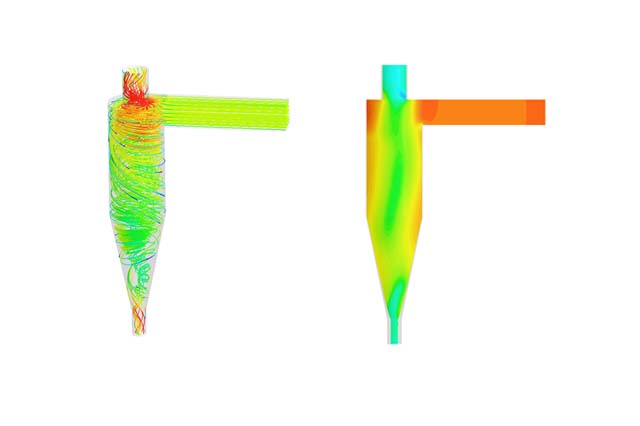The Cyclone Separator is important in many industries. It separates solid particles from gas streams. Employing centrifugal force generated by a spinning gas, cyclone separators are vital for ensuring clean gas discharge.
In this case study, we delve into the comprehensive Computational Fluid Dynamics (CFD) analysis conducted on a Cyclone Separator. The primary objective is to evaluate its overall performance under varying conditions of inlet velocity, flow rate, and particle diameter. We conduct this by utilizing a multiphase discrete Phase Model (DPM) coupled with the K-ꞷ SST turbulence model.
The CFD analysis provides insights into the dynamic behavior of the cyclone separator. Key parameters, such as inlet velocity, flow rate, and particle diameter, are systematically varied to understand their impact on the performance of the separator. Using a DPM model helps study particle paths in gas, giving a complete understanding of separation.

Multiphase DPM Model and K-ꞷ SST Turbulence Model:
A multiphase DPM model is used to simulate flows with particles. This is important for evaluating the efficiency of particle separation in a cyclone separator. The K-ꞷ SST turbulence model is used to study the turbulence of gas flow. It helps in understanding the fluid dynamics involved in the separation process.
Parameters Evaluated:
Performance Evaluation:
The CFD analysis reveals a nuanced understanding of the cyclone separator performance under varying conditions. Through the examination of pressure, temperature, velocity distribution, and particle diameter distribution, the study identifies optimal operating parameters that maximize separation efficiency.
Optimization Strategies:
Using the CFD analysis findings, we create strategies to improve the cyclone separator overall performance. These strategies may involve adjustments to inlet conditions, modifications to the separator geometry, or the implementation of advanced materials to withstand varying particle loads.
Real-World Applications:
The outcomes of the CFD analysis extend beyond theoretical insights, finding practical applications in industries reliant on cyclone separator. You can implement the optimized operating parameters to achieve enhanced efficiency, reduce energy consumption, and prolong equipment lifespan. Industries such as mining, petrochemicals, and environmental management stand to benefit significantly from these findings.
Challenges and Future Considerations:
The study shows problems faced during the CFD analysis, stressing the importance of improving simulation models consistently. Future plans include incorporating real-world conditions, confirming CFD results with experiments, and studying advanced turbulence models to improve simulation accuracy.
Conclusion:
One of In conclusion, the CFD analysis of the Cyclone Separator serves as a pivotal tool for evaluating and optimizing its performance. The utilization of a multiphase DPM model and the K-ꞷ SST turbulence model enables a comprehensive examination of the separator's behavior under varying conditions.
The insights gained contribute not only to theoretical understanding but also to practical applications in industries reliant on efficient particle separation. As industries continue to advance, the integration of CFD analysis in the design and optimization of cyclone separator will play a crucial role in ensuring sustainable and high-performance gas-solid separation processes.